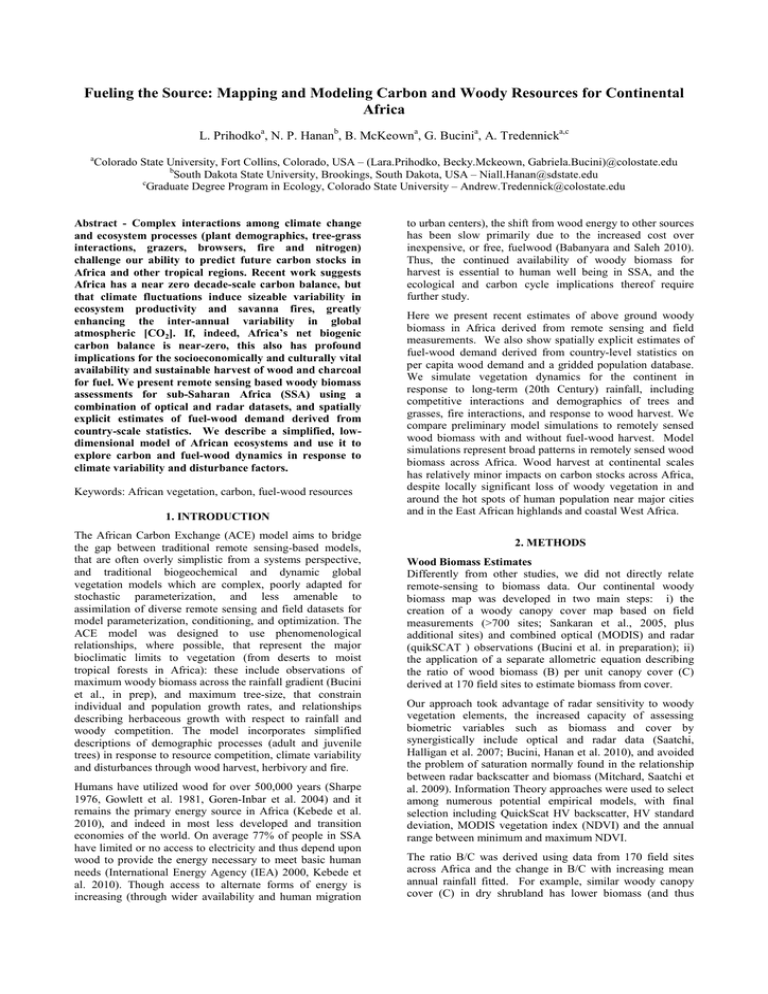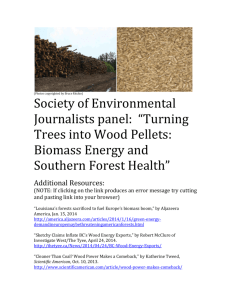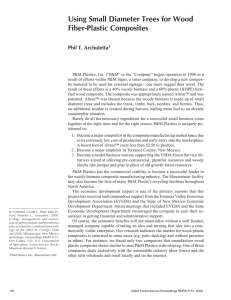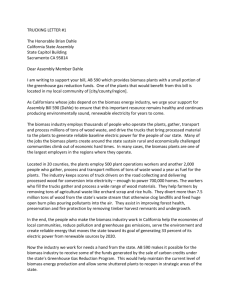Fueling the Source: Mapping and Modeling Carbon and Woody Resources... Africa L. Prihodko
advertisement

Fueling the Source: Mapping and Modeling Carbon and Woody Resources for Continental Africa L. Prihodkoa, N. P. Hananb, B. McKeowna, G. Bucinia, A. Tredennicka,c a Colorado State University, Fort Collins, Colorado, USA – (Lara.Prihodko, Becky.Mckeown, Gabriela.Bucini)@colostate.edu b South Dakota State University, Brookings, South Dakota, USA – Niall.Hanan@sdstate.edu c Graduate Degree Program in Ecology, Colorado State University – Andrew.Tredennick@colostate.edu Abstract - Complex interactions among climate change and ecosystem processes (plant demographics, tree-grass interactions, grazers, browsers, fire and nitrogen) challenge our ability to predict future carbon stocks in Africa and other tropical regions. Recent work suggests Africa has a near zero decade-scale carbon balance, but that climate fluctuations induce sizeable variability in ecosystem productivity and savanna fires, greatly enhancing the inter-annual variability in global atmospheric [CO2]. If, indeed, Africa’s net biogenic carbon balance is near-zero, this also has profound implications for the socioeconomically and culturally vital availability and sustainable harvest of wood and charcoal for fuel. We present remote sensing based woody biomass assessments for sub-Saharan Africa (SSA) using a combination of optical and radar datasets, and spatially explicit estimates of fuel-wood demand derived from country-scale statistics. We describe a simplified, lowdimensional model of African ecosystems and use it to explore carbon and fuel-wood dynamics in response to climate variability and disturbance factors. Keywords: African vegetation, carbon, fuel-wood resources 1. INTRODUCTION The African Carbon Exchange (ACE) model aims to bridge the gap between traditional remote sensing-based models, that are often overly simplistic from a systems perspective, and traditional biogeochemical and dynamic global vegetation models which are complex, poorly adapted for stochastic parameterization, and less amenable to assimilation of diverse remote sensing and field datasets for model parameterization, conditioning, and optimization. The ACE model was designed to use phenomenological relationships, where possible, that represent the major bioclimatic limits to vegetation (from deserts to moist tropical forests in Africa): these include observations of maximum woody biomass across the rainfall gradient (Bucini et al., in prep), and maximum tree-size, that constrain individual and population growth rates, and relationships describing herbaceous growth with respect to rainfall and woody competition. The model incorporates simplified descriptions of demographic processes (adult and juvenile trees) in response to resource competition, climate variability and disturbances through wood harvest, herbivory and fire. Humans have utilized wood for over 500,000 years (Sharpe 1976, Gowlett et al. 1981, Goren-Inbar et al. 2004) and it remains the primary energy source in Africa (Kebede et al. 2010), and indeed in most less developed and transition economies of the world. On average 77% of people in SSA have limited or no access to electricity and thus depend upon wood to provide the energy necessary to meet basic human needs (International Energy Agency (IEA) 2000, Kebede et al. 2010). Though access to alternate forms of energy is increasing (through wider availability and human migration to urban centers), the shift from wood energy to other sources has been slow primarily due to the increased cost over inexpensive, or free, fuelwood (Babanyara and Saleh 2010). Thus, the continued availability of woody biomass for harvest is essential to human well being in SSA, and the ecological and carbon cycle implications thereof require further study. Here we present recent estimates of above ground woody biomass in Africa derived from remote sensing and field measurements. We also show spatially explicit estimates of fuel-wood demand derived from country-level statistics on per capita wood demand and a gridded population database. We simulate vegetation dynamics for the continent in response to long-term (20th Century) rainfall, including competitive interactions and demographics of trees and grasses, fire interactions, and response to wood harvest. We compare preliminary model simulations to remotely sensed wood biomass with and without fuel-wood harvest. Model simulations represent broad patterns in remotely sensed wood biomass across Africa. Wood harvest at continental scales has relatively minor impacts on carbon stocks across Africa, despite locally significant loss of woody vegetation in and around the hot spots of human population near major cities and in the East African highlands and coastal West Africa. 2. METHODS Wood Biomass Estimates Differently from other studies, we did not directly relate remote-sensing to biomass data. Our continental woody biomass map was developed in two main steps: i) the creation of a woody canopy cover map based on field measurements (>700 sites; Sankaran et al., 2005, plus additional sites) and combined optical (MODIS) and radar (quikSCAT ) observations (Bucini et al. in preparation); ii) the application of a separate allometric equation describing the ratio of wood biomass (B) per unit canopy cover (C) derived at 170 field sites to estimate biomass from cover. Our approach took advantage of radar sensitivity to woody vegetation elements, the increased capacity of assessing biometric variables such as biomass and cover by synergistically include optical and radar data (Saatchi, Halligan et al. 2007; Bucini, Hanan et al. 2010), and avoided the problem of saturation normally found in the relationship between radar backscatter and biomass (Mitchard, Saatchi et al. 2009). Information Theory approaches were used to select among numerous potential empirical models, with final selection including QuickScat HV backscatter, HV standard deviation, MODIS vegetation index (NDVI) and the annual range between minimum and maximum NDVI. The ratio B/C was derived using data from 170 field sites across Africa and the change in B/C with increasing mean annual rainfall fitted. For example, similar woody canopy cover (C) in dry shrubland has lower biomass (and thus lower B/C) than in moist tropical forests. We applied a linear regression for B/C as a function of mean annual precipitation (PPT) (B/C ~ PPT, r2 = 0.59) and then predicted biomass for Africa from the woody cover dataset. Figure 1. Above ground wood biomass for sub-Saharan Africa. Estimates were derived from >700 field measurements used to calibrate an empirical relationship at 1 km resolution with Quickscat radar and MODIS vegetation index and then aggregated to 0.5o x 0.5o grid-cells for this analysis. Fuel-wood demand Fuel-wood demand is based on country-level statistics obtained from the United Nations Food and Agriculture Organization (FAO) Forestry Database (Food and Agriculture Organization of the United Nations 2010). The FAO database reports for each country estimates of wood that is harvested and used locally for fuel – either directly as wood or converted to and combusted as charcoal. For this analysis we assume that the FAO data provide an accurate reflection of fuelwood demand, although comparison with the relatively small literature reporting local assessments suggests that FAO tend to underestimate total consumption. Country-scale estimates from 2008 were converted to kg/country/year from m3/country/year using the average wood density for African species (605 kg/m3) as reported in the Global Wood Density Database (Zanne et al. 2009). We then converted to kg/person/year using total population data for each country from the 2005 Gridded Population of the World database (Center for International Earth Science Information Network 2005). We then applied the per capita fuelwood demand estimates back to the gridded population database at the spatial resolution of 2.5’. Using this approach we obtain spatially detailed (2.5’) estimates of fuelwood demand at scales well below national levels (Tredennick et al., in prep). African Carbon Exchange Model The African Carbon Exchange (ACE) model is an extension to the model described by Hanan et al (2008). It conceives of trees and grasses that compete for water and are impacted by climate (including long-term changes in climate and [CO2]), nitrogen availability, herbivores and fires. The major difference with respect to the earlier model is that woody and herbaceous leaf production, and woody growth and mortality, are dynamic functions of annual rainfall, and we add consideration of fuel-wood harvest, grazer and browser dynamics and their response to, and effect on, vegetation productivity, nitrogen and stochastic fire dynamics. Simulations use the ~100 year (1902-2006) actual rainfall analysis provided by the Climate Research Unit (CRU; Mitchell and Jones, 2005), with a single cycle used for initial spin-up, and two cycles used for model integration with, and without, wood harvest taken into account. Figure 2. Fuel-wood demand in Africa (kg/ha/year). Estimates were derived from FAO country-level statistics and a gridded human population database at 2.5’ resolution and then aggregated to 0.5o x 0.5o grid-cells for this analysis. 3. RESULTS AND DISCUSSION Wood biomass estimates for Africa are shown in Figure 1 aggregated to a 0.5o x 0.5o grid scale used for model simulations. These estimates are derived from our woody canopy cover analysis based on a large number (>700) of field sites with measured cover, and empirical relationships with Qscat radar (HV backscatter, HV standard deviation) and MODIS optical vegetation indices (NDVI; mean NDVI annual range) (Bucini et al., in prep). We then converted canopy cover estimates to biomass estimates using the B/C allometry discussed above. In future we will extend these relationships to represent uncertainty propagation from woody cover, through the B/C relationship, to biomass estimates. Fuel wood demand estimates for Africa are shown in Figure 2. Annual demand across most of Africa is ~2 orders of magnitude smaller than standing biomass stocks, except in harvest ‘hot spots’ in the high population centers near larger cities, in the east African highlands of Ethiopia, Kenya and the Rift Valley, and in coastal West Africa of Nigeria where maximum ‘demand’ at the 0.5o x 0.5o spatial resolution can be as high as 10,000 kg/ha/year. Preliminary model simulations of above ground woody biomass are shown for the final year of a ~315 year simulation (105 year spin-up, followed by 210 year integration) without impacts of wood harvest (Figure 3) and with fuel-wood harvest (‘demand’) subtracted each year and thereby impacting both standing stock of biomass, grass growth, fire frequency and woody demographics (Figure 4). For the moist tropical rainforest, the semi-arid savannas, and the arid deserts, model simulations of woody biomass are well correlated with observed woody biomass (compare Figs 3-4 relative to Fig. 1). Wood harvest impacts in these regions are relatively modest in most areas except in some more densely populated zones where wood harvest overwhelms the productive capacity of the systems and woody biomass stocks decline to near zero (Figs 3 & 4). On the other hand, model simulations in the mesic savannas show more evidence of bifurcations (for example the dark blue speckling in the miombo woodlands south of the Congo basin) relative to satellite-derived estimates of actual biomass. In these areas, tree cover in some grid cells declines to near-zero because of fire and the positive feedback between fire, adult and juvenile tree survival, and grass Figure 3. ACE Model above ground wood biomass simulations for sub-Saharan Africa without the fuel-wood harvest effect. 4. CONCLUSIONS The African Carbon Exchange (ACE) model is intended to represent the broad patterns of vegetation dynamics in response to climate and management using a lowdimensional model with ecological realism. The model seeks to balance simplicity and realism that will allow it to be used with a variety of satellite data products in a formal dataassimilation framework, using satellite products including biomass and leaf area index products, and fire frequency. Our intent is to simulate the dynamics that control long-term carbon fluxes, including changes in above-ground and below-ground woody biomass, and changing soil carbon content. These pools represent the only opportunity for longterm changes in carbon balance of the continent and are thus the crucial pools to model in this model-data assimilation framework. ACE seeks to track changes in these pools as they respond to woody population demographics and responses to varying climate, wood harvest, agricultural conversion, fire and herbivory (although not all of these processes are yet incorporated in this version of the model). The bifurcation between high and low woody biomass simulated by ACE in the mesic savannas appears to exaggerate real fire feedbacks in the tree-grass system when compared to satellite biomass estimates. This bifurcation emerges in the model through the interactions between treegrass competition and grass growth that controls fire frequency and resulting woody mortality, parameterised using field-observed relationships. That the model exaggerates patterns in the mesic regions may be a simple production. The stochastic fire model (where fire occurrence depends on grass biomass/fuel-load that defines a mean fire probability with a stochastic adjustment for actual fire occurrence) seeds in additional spatial variability in these mesic savanna areas, that exceeds the variability in ‘actual biomass’. Wood harvest in these areas also has relatively minor impact but increases the frequency of these bifurcations. Figure 4. ACE Model above ground wood biomass simulations for sub-Saharan Africa with fuel-wood harvest effect. response to model and/or parameter error and uncertainty. However, it may also reflect that fire occurrence in these areas is too high because herbivore consumption effects on grass biomass/fuel-load are not yet included. Inclusion of herbivory (wild and domestic mammalian herbivores, insects) will provide stabilising mechanisms that we hypothesize will act together with fuel-wood harvest to reduce bifurcation tendencies and maintain the tree-grass mixtures characteristic of the vast savanna regions of Africa. 5. REFERENCES Babanyara, Y. Y. and U. F. Saleh. 2010. Urbanisation and the Choice of Fuel Wood as a Source of Energy in Nigeria, Journal of Human Ecology 31:19-26. Bucini, G. and N. P. Hanan (2007). A continental-scale analysis of tree cover in African savannas, Global Ecology and Biogeography 16(5): 593-605. Bucini, G., N. P. Hanan, et al. (2010). Woody fractional cover in Kruger National Park, South Africa: remote-sensing-based maps and ecological insights. Ecosystem Function in Savannas: measurement and modeling at landscape to global scales. M. J. Hill and N. P. Hanan, Boca Raton, CRC Press. Center for International Earth Science Information Network. 2005. Gridded Population of the World (GPW). Columbia University; International Food Policy Research Institute (IFPRI); and World Resources Institute (WRI), New York. Food and Agriculture Organization of the United Nations. 2010. FAOSTAT 2010 Database. UNFAO, Rome. Goren-Inbar, N., N. Alperson, M. E. Kislev, O. Simchoni, Y. Melamed, A. Ben-Nun, and E. Werker. 2004. Evidence of Hominin Control of Fire at Gesher Benot Ya`aqov, Israel. Science 304:725-727. Gowlett, J. A. J., J. W. K. Harris, D. Walton, and B. A. Wood. 1981. Early archaeological sites, hominid remains and traces of fire from Chesowanja, Kenya. Nature 294:125-129. Hanan, N. P., W. B. Sea, G. Dangelmayr and N. Govender (2008). Do fires in savannas consume woody biomass? A comment on approaches to modeling savanna dynamics, American Naturalist 171(6): 851-856. Hutchinson, M. F., H. A. Nix, et al. (1996). The development of a topographic and climate database for Africa, Proceedings of the Third International Conference/Workshop on Integrating GIS and Environmental Modeling, NCGIA, Santa Barbara, California. International Energy Agency (IEA). 2000. World Energy Outlook, 2000. International Energy Agency, Economic Analysis Division, France. Kebede, E., J. Kagochi, and C. M. Jolly. 2010. Energy consumption and economic development in SubSahara Africa. Energy Economics 32:532-537. Mitchard, E. T. A., S. S. Saatchi, et al. (2009). Measuring Woody Encroachment along a Forest-Savanna Boundary in Central Africa, Earth Interactions 13: 29.Sharpe, G. W. 1976. Introduction to Forestry. 4th edition. MacGraw-Hill Book Company, New York. Mitchell, T. and Jones, D., 2005, An improved method of constructing a database of monthly climate observations and associated high-resolution grids, International Journal fo Climatology, 25, 693-712. Saatchi, S., K. Halligan, et al. (2007). Estimation of forest fuel load from radar remote sensing, IEEE Transactions on Geoscience and Remote Sensing 45(6): 1726-1740. Sankaran, M., N. P. Hanan, et al. (2005). Determinants of woody cover in African savannas, Nature 438(7069): 846-849 Sharpe, G. W. 1976. Introduction to Forestry. 4th edition. MacGraw-Hill Book Company, New York. Zanne, A. E., G. Lopez-Gonzalez, D. A. Coomes, J. Illic, S. Jansen, S. L. Lewis, R. B. Miller, N. G. Swenson, M. C. Wiemann, and J. Chave. 2009. Global wood density database. Dryad. 6. ACKNOWLEDGEMENTS The NASA Terrestrial Ecology Program supports the African Carbon Exchange (ACE) Research Project. Additional support was provided by the National Science Foundation (NSF), and the National Oceanographic and Atmospheric Administration (NOAA).







